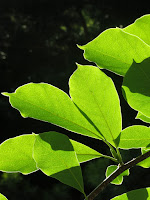 While on my recent trip to France we had the opportunity to visit Jardin Serre de la Madone in Menton.
While on my recent trip to France we had the opportunity to visit Jardin Serre de la Madone in Menton. The garden was created in 1924-1939 by Lawrence Johnston, the same gentlemen who created Hidcote Manor Garden in 1907. Mr. Johnston "retired" and created the Jardin Serre de la Madone on his own property in the Gorbio Valley.
The garden occupies a former terraced hillside Olive grove and farmhouse that Johnston remodeled. One of the reasons he selected the site is that it offered a subtropical microclimate for his plant collection. Over the years he expanded the garden all the way down the hillside. After his death the garden fell into disrepair. In 1999 the property was purchased by the non-profit Conservatoire du Littoral, who began restoring it to Johnson's design.
| The property has several structures on it, my favorite being the "cool" greenhouse. It's a stone structure perched on the terrace and served as a sort of lath house for some of the tropicals. |  |



It was fun to see Sotol in big pots flanking one of the many staircases. Big clumps of Bird of Paradise beckoned you to explore a fountain hidden in a leafy bower.

The moorish garden once had an aviary in the courtyard. Now it's main feature is the mirror pond.



This variegated Alstroemeria lit up one shady spot while tree leaves caught the sun in another.

 We were shown around the garden by the head of horticulture (so sorry that I didn't write down his name!) He gave us a history and pointed out some of the water conservation features. Of course being a group of gardeners he was peppered with "what's this plant?" Finally, clearly exacerbated, he proclaimed "Mon ami, we have over 6,000 plants, I can't possibly know them all!"
We were shown around the garden by the head of horticulture (so sorry that I didn't write down his name!) He gave us a history and pointed out some of the water conservation features. Of course being a group of gardeners he was peppered with "what's this plant?" Finally, clearly exacerbated, he proclaimed "Mon ami, we have over 6,000 plants, I can't possibly know them all!"Fair enough. Left to wander on our own I captured photos of plants I found interesting. Every terrace revealed new structures, water features, both tiny and large discoveries.
 |
| The Belvedere |
 |
| Potato vine |
 |
| Eucalyptus |
This garden was meant to be explored and I could have spent days there. I imagined Mr. Johnston tucking a plant here and a seating area there as he expanded the garden down the hillside. It was highly designed yet still rough and tumble enough to get lost on a wandering path. When I think of it now it's hard for me to call it a single garden since there were so many individual features - a theme common among plant collectors (and my own jungle.) This would be a place I'd love to work or volunteer at. Perhaps something for my retirement? Need to start learning French!!



It must have been both fun and interesting to garden in a completely different climate. I have often wondered how someone could leave a garden like Hidcote but I could certainly leave my own garden for a chance to garden in the South of France. The weather would also be a significant attractant after the cold winters in the Cotswolds.
ReplyDeleteWandering on my own is my favorite way to see a garden, and this one sounds like a joy to explore. I was interested to hear about the rainwater capture too.
ReplyDelete